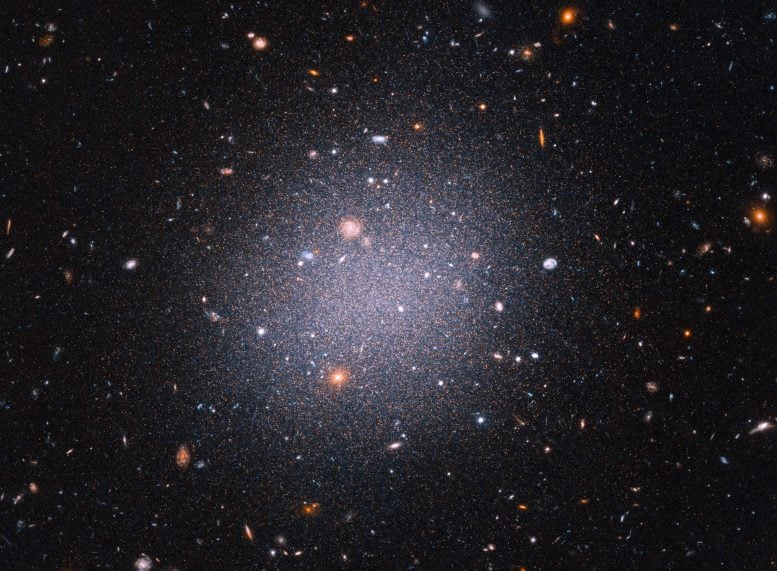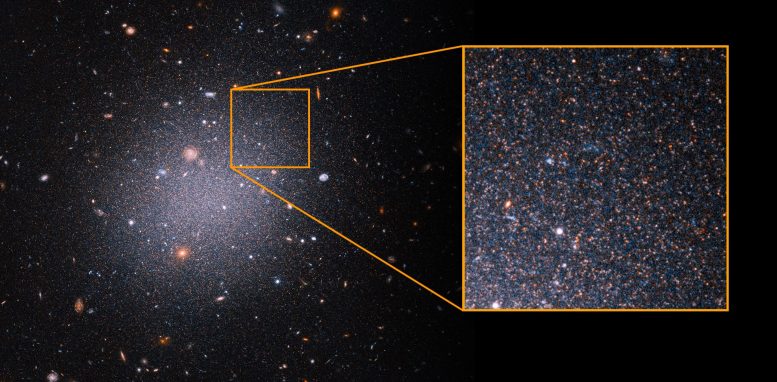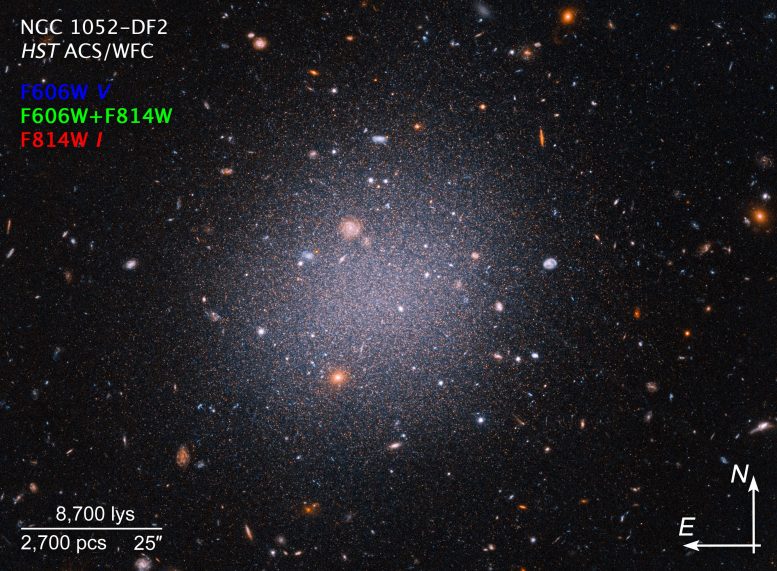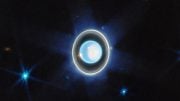
This Hubble Space Telescope snapshot reveals an unusual “see-through” galaxy. The giant cosmic cotton ball is so diffuse and its ancient stars so spread out that distant galaxies in the background can be seen through it. Called an ultra-diffuse galaxy, this galactic oddball is almost as wide as the Milky Way, but it contains only 1/200th the number of stars as our galaxy. The ghostly galaxy doesn’t appear to have a noticeable central region, spiral arms, or a disk. Researchers calculated a more accurate distance to the galaxy, named NGC 1052-DF2, or DF2, by using Hubble to observe about 5,400 aging red giant stars. Red giant stars all reach the same peak brightness, so they are reliable yardsticks to measure distances to galaxies. The research team estimates that DF2 is 72 million light-years from Earth. They say the distance measurement solidifies their claim that DF2 lacks dark matter, the invisible glue that makes up the bulk of the universe’s contents. The galaxy contains at most 1/400th the amount of dark matter that the astronomers had expected. The observations were taken between December 2020 and March 2021 with Hubble’s Advanced Camera for Surveys. Credit: Science: NASA, ESA, STScI, Zili Shen (Yale), Pieter van Dokkum (Yale), Shany Danieli (IAS) Image Processing: Alyssa Pagan (STScI)
Precise Distance to Galaxy Bolsters Missing Dark Matter Claim
What if oceanographers found the “tip” of an iceberg and nothing else? Mysteriously missing was the iceberg’s immense body, which extends far below the waves.
Astronomers faced this puzzle when they aimed Hubble at the spheroidal galaxy NGC 1052-DF2, or DF2. It looks like a denizen of intergalactic space that is the closest thing there is to nothing, but is still something. It’s physically larger than our Milky Way, but its loose beehive swarm of stars is so thinly scattered that Hubble sees right through it, capturing myriad background galaxies.
The missing “bottom of the iceberg” for DF2 is the lack of dark matter. Galaxies are partly made up of visible matter—stars and gas. But the bulk of a galaxy’s makeup is in dark matter, the invisible glue that keeps a lid on stars, so they don’t escape from the galaxy.
Because this innocuous galaxy challenges conventional theories of how galaxies are put together, astronomers were naturally skeptical when it was first announced that the universe harbored such a rule breaker. After all, the entire cosmos is built on the invisible scaffolding of dark matter.
To double-check their conclusion, the researchers used a lot more Hubble exposures to better nail down the distance to the stealthy galaxy. If DF2 were closer than they thought, the dark matter mystery goes away.
They actually found that the galaxy is a little bit farther away than first measured. The researchers say the new milepost helps them confirm that dark matter is really missing in the galactic oddball. They say it’s now up to theorists to figure out why.
When astronomers using NASA’s Hubble Space Telescope uncovered an oddball galaxy that looks like it doesn’t have much dark matter, some thought the finding was hard to believe and looked for a simpler explanation. Dark matter, after all, is the invisible glue that makes up the bulk of the universe’s contents. All galaxies are dominated by it; in fact, galaxies are thought to form inside immense halos of dark matter. So, finding a galaxy lacking the invisible stuff is an extraordinary claim that challenges conventional wisdom. It would have the potential to upset theories of galaxy formation and evolution. Credit: NASA’s Goddard Space Flight Center
When astronomers using NASA’s Hubble Space Telescope uncovered an oddball galaxy that looked like it didn’t have much dark matter, some thought the finding was hard to believe and looked for a simpler explanation.
Dark matter, after all, is the invisible glue that makes up the bulk of the universe’s matter. All galaxies appear to be dominated by it; in fact, galaxies are thought to form inside immense halos of dark matter.
So, finding a galaxy lacking the invisible stuff is an extraordinary claim that challenges conventional wisdom. It would have the potential to upset theories of galaxy formation and evolution.
To bolster their original finding, first reported in 2018 (Dark Matter Goes Missing in Oddball Galaxy), a team of scientists led by Pieter van Dokkum of Yale University in New Haven, Connecticut, followed up their initial study with a more robust Hubble look at the galaxy, named NGC 1052-DF2. Scientists refer to it simply as “DF2.”
“We went out on a limb with our initial Hubble observations of this galaxy in 2018,” van Dokkum said. “I think people were right to question it because it’s such an unusual result. It would be nice if there were a simple explanation, like a wrong distance. But I think it’s more fun and more interesting if it actually is a weird galaxy.”
Determining the amount of the galaxy’s dark matter hinges on accurate measurements of how far away it is from Earth.
If DF2 is as far from Earth as van Dokkum’s team asserts, the galaxy’s dark-matter content may only be a few percent. The team’s conclusion is based on the motions of the stars within the galaxy; their velocities are influenced by the pull of gravity. The researchers found that the observed number of stars accounts for the galaxy’s total mass, and there’s not much room left for dark matter.
However, if DF2 were closer to Earth, as some astronomers claim, it would be intrinsically fainter and less massive. The galaxy, therefore, would need dark matter to account for the observed effects of the total mass.

This Hubble Space Telescope image offers a sampling of aging, red stars in the ultra-diffuse galaxy NGC 1052-DF2, or DF2. The galaxy continues to puzzle astronomers because it is lacking dark matter, an invisible form of matter that provides the gravitational glue to hold galaxies together. Precisely establishing the galaxy’s distance form Earth is a step toward solving the mystery. The close-up at right reveals the many aging red giant stars on the outskirts of the galaxy that are used as intergalactic milepost markers. Researchers calculated a more accurate distance to DF2 by using Hubble to observe about 5,400 red giants. These older stars all reach the same peak brightness, so they are reliable yardsticks to measure distances to galaxies. The research team estimates that DF2 is 72 million light-years from Earth. They say the distance measurement solidifies their claim that DF2 lacks dark matter. The galaxy contains at most 1/400th the amount of dark matter that the astronomers had expected, based on theory and observations of many other galaxies. Called an ultra-diffuse galaxy, the galactic oddball is almost as wide as the Milky Way, but it contains only 1/200th the number of stars as our galaxy. The ghostly galaxy doesn’t appear to have a noticeable central region, spiral arms, or a disk. The observations were taken between December 2020 and March 2021 with Hubble’s Advanced Camera for Surveys. Credit: Science: NASA, ESA, STScI, Zili Shen (Yale), Pieter van Dokkum (Yale), Shany Danieli (IAS) Image Processing: Alyssa Pagan (STScI)
A Better Yardstick
Team member Zili Shen, from Yale University, says that the new Hubble observations help them confirm that DF2 is not only farther from Earth than some astronomers suggest, but also slightly more distant than the team’s original estimates.
The new distance estimate is that DF2 is 72 million light-years as opposed to 42 million light-years, as reported by other independent teams. This places the galaxy farther than the original Hubble 2018 estimate of 65 light-years distance.
The research team based its new result on long exposures with Hubble’s Advanced Camera for Surveys, which provide a deeper view of the galaxy for finding a reliable yardstick to nail down the distance. They targeted aging red giant stars on the outskirts of the galaxy that all reach the same peak brightness in their evolution. Astronomers can use the stars’ intrinsic brightness to calculate vast intergalactic distances. “Studying the brightest red giants is a well-established distance indicator for nearby galaxies,” Shen explained.
The more accurate Hubble measurements solidify the researchers’ initial conclusion of a galaxy deficient in dark matter, team members say. So the mystery of why DF2 is missing most of its dark matter still persists.
“For almost every galaxy we look at, we say that we can’t see most of the mass because it’s dark matter,” van Dokkum explained. “What you see is only the tip of the iceberg with Hubble. But in this case, what you see is what you get. Hubble really shows the entire thing. That’s it. It’s not just the tip of the iceberg, it’s the whole iceberg.”
The team’s science paper has been published in The Astrophysical Journal Letters.

This Hubble Space Telescope snapshot reveals an unusual “see-through” galaxy. The giant cosmic cotton ball is so diffuse and its ancient stars so spread out that distant galaxies in the background can be seen through it. Called an ultra-diffuse galaxy, this galactic oddball is almost as wide as the Milky Way, but it contains only 1/200th the number of stars as our galaxy. The ghostly galaxy doesn’t appear to have a noticeable central region, spiral arms, or a disk. Credit: Science: NASA, ESA, STScI, Zili Shen (Yale), Pieter van Dokkum (Yale), Shany Danieli (IAS) Image Processing: Alyssa Pagan (STScI)
A Stealthy Galaxy
DF2 is a giant cosmic cotton ball that van Dokkum calls a “see-through galaxy,” where the stars are spread out. The galactic oddball is almost as wide as the Milky Way, but it contains only 1/200th the number of stars as our galaxy.
The ghostly galaxy doesn’t appear to have a noticeable central region, spiral arms, or a disk. The team estimates that DF2 contains at most 1/400th the amount of dark matter than astronomers had expected. How the galaxy formed remains a complete mystery based on the team’s latest measurements.
DF2 isn’t the only galaxy devoid of dark matter. Shany Danieli of the Institute for Advanced Study in Princeton, New Jersey, used Hubble in 2020 to obtain an accurate distance to another ghostly galaxy, called NGC 1052-DF4 (or simply DF4), which apparently lacks dark matter, too. In this case, however, some scientists suggest the dark matter may have been stripped out of the galaxy due to tidal forces from another galaxy.
The researchers think both DF2 and DF4 were members of a collection of galaxies. However, the new Hubble observations show that the two galaxies are 6.5 million light-years away from each other, farther apart than they first thought. It also appears that DF2 has drifted away from the grouping and is isolated in space.
Both galaxies were discovered with the Dragonfly Telephoto Array at the New Mexico Skies Observatory.
“Both of them probably were in the same group and formed at the same time,” Danieli said. “So maybe there was something special in the environment where they were formed.”
The researchers are hunting for more of these oddball galaxies. Other teams of astronomers are searching, too. In 2020, a group of researchers uncovered 19 unusual dwarf galaxies they say are deficient in dark matter (Off the Baryonic Tully–Fisher Relation: A Population of Baryon-dominated Ultra-diffuse Galaxies – IOPscience ). However, it will take uncovering many more dark matter-less galaxies to resolve the mystery.
Nevertheless, van Dokkum thinks finding a galaxy lacking dark matter tells astronomers something about the invisible substance. “In our 2018 paper, we suggested that if you have a galaxy without dark matter, and other similar galaxies seem to have it, that means that dark matter is actually real and it exists,” van Dokkum said. “It’s not a mirage.”
Reference: “A Tip of the Red Giant Branch Distance of 22.1 ± 1.2 Mpc to the Dark Matter Deficient Galaxy NGC 1052–DF2 from 40 Orbits of Hubble Space Telescope Imaging” by Zili Shen, Shany Danieli, Pieter van Dokkum, Roberto Abraham, Jean P. Brodie, Charlie Conroy, Andrew E. Dolphin, Aaron J. Romanowsky, J. M. Diederik Kruijssen and Dhruba Dutta Chowdhury, 9 June 2021, The Astrophysical Journal Letters.
DOI: 10.3847/2041-8213/ac0335
The Hubble Space Telescope is a project of international cooperation between NASA and ESA (European Space Agency). NASA’s Goddard Space Flight Center in Greenbelt, Maryland, manages the telescope. The Space Telescope Science Institute (STScI) in Baltimore, Maryland, conducts Hubble science operations. STScI is operated for NASA by the Association of Universities for Research in Astronomy in Washington, D.C.









… “What if oceanographers found the “tip” of an iceberg and nothing else? Mysteriously missing was the iceberg’s immense body, which extends far below the waves.”…
… it just means that this parallel is not working, try to use some ellipses instead, …
We have seen examples of a black hole being ejected from a galaxy so it is not that big a stretch to imagine both black holes being slingshotted out and taking most of the dark matter with them.
Nor is it such a big stretch to imagine that Black Holes don’t exist at all and that the effects of angular momentum take effect on much grander (and smaller) scales than we the public appreciate, or than scientists will publicly discuss.
That would be an enormous stretch that couldn’t take on observations – see the video.
Dark matter exists, which is why scientists deals with it.
THIS HINTS AT EXISTENCE OF MORE FORCES THAN WE RECOGNIZED.
No it doesn’t. It “hints” (confirms) that the astronomers don’t have a bloody clue what they’re talking about and are just speculating rather than seeking, discovering and analysing information. Y’know, the way a real scientist does?
Are you saying that astronomers, historically among the first scientists, are somehow not scientists?
Maybe you don’t know what astronomy – or dark matter – is.
I recall the at times rancorous dialogues that followed the conflicting distances. The arguments took place beginning over a year ago and are finally being resolved.
Look at results and reformulate what happened. Obsreve again and match against predictions again.
And again.
And again, repeating as necessary, years are spent getting to one piece of the true nature our universe.
Y’know, the way real scientists do it.
Seems to me that with every ‘check’, we revise our data… and not by any small margins… so how long until we revise this data again?!!
This is why we must take all assumptions based upon astronomical measurement with one VERY large grain of NaCl.
? Before 1998 and the discovery of dark energy we didn’t know the universe age within a factor 2. Today we have precision cosmology where both the latest eBOSS and DES galaxy surveys independently lies at 1 % remaining uncertainty in their cosmology – which agrees and need no “revision” as of yet.
We’ll take you with a very large grain of salt, since you know nothing about what you futilely protest.
The video can hope it will lead to problems with current cosmology but the finding seems to be expected:
“The researchers used the Illustris simulation to investigate the origin of odd dwarf galaxies such as DF2 and DF4. They found simulated analogs to dark-matter-free dwarfs in the form of objects that had evolved within the galaxy clusters for a long time and lost more than 90% of their dark matter via tidal stripping — the stripping away of material by galactic tidal forces.”
[ https://www.sciencedaily.com/releases/2021/02/210209151829.htm ]
The first thing I thought of when I saw this is that the discovery all but entirely disproves the concept of Modified Newtonian Dynamics as an alternative to dark matter. Gravity isn’t going to behave differently in different galaxies.
Dark matter is simply a name invented to explain a phenomenon we don’t understand. When light was found to have a wave form we invented the ether. New understanding sent that one to the dustbin of history. Dark matter will go the same way. Personally I think our incomplete understanding of gravity is at fault here, just as quantum physics replaced classical physics, and Einstein replaced Newtonian.
Hmmm… 72 MILLION light-years (and “shifting”), you say… So… this “picture” is what this “cloud-like ‘galaxy'” looked like when DINOSAURS roamed the earth. I THINK that, at that distance/Time (distance=time) ratio, the MISTER MAGOO (Googlie it) EFFECT takes over; i.e., Scientific MYOPIA: Magoo sees a pretty woman approaching. She has golden tresses, is wearing a grass hula skirt, and a coconut shell brassiere. Her ruby lips are smiling beneath eyes of China Blue. She’s motioning to him with a provocative nod… It’s a damn SHEEP DOG. WISH FULFILLMENT, tailor-made to fit his desire(s). The suit doesn’t fit? TAILOR it to fit from the WHOLE CLOTH of imagination. It ain’t ROCKET SCIENCE. It ain’t Science at ALL. Tune in DOCTOR BECKY if you want the SKINNY on the latest Scientific “Fashion”; complete with the latest MATHS to substantiate their speculation(s). All in a day’s work. On with the SHOW.
PARADIGM SHIFT: One can only wonder. Wonder fuels the ENGINE of IMAGINATION. Imagination often carries INSIGHT in its wake. But you have to WAIT for it. FIXING our perceptions (as a BUTTERFLY is fixed upon a pin), may PRESERVE our ORTHODOX vision of “What it is” but it stills the living process. In the final analysis, it’s just a DEAD THING, rotting in a museum; it’s wing-beat stilled in mid-stroke. It used to fly, but now must do so in our imaginations alone: SCIENCE FICTION…by any other name.
We’ll get there; one step at a time. PEDANTIC. Not in 72 million years.
QUANTUM LEAP: The Universe neither conforms to, nor confirms our expectations. It is SOMETHING COMPLETELY DIFFERENT to our Earth-bound perceptions. We are IN it, and OF it. Thus SPAKE The Oracle of Delphi: KNOW THYSELF. 👽
The JOURNEY starts there.
Warp 10, Mister Warf. Make it so. (Que Orchestra: Thus Spake Zarathustra)
🦋
Does anyone know if the rate of rotation of stars at this galaxy’s rim are moving at the same angular rate as those near the center? Seems like a golden opportunity to test the first reason dark matter was stipulated.
On reflection, how does this galaxy exist? If its spherical, and is not rotating, it seems gravity should collapse it. If it is rotating, how do the stars at the poles of the rotation axis keep from falling inward due to gravity, and the whole thing flattening to a disk? Any ideas out there?
Because it’s a NEW galaxy. When the stars start falling inward, then the central Black Hole will start to form. That’s a SWAG, “Scientific Wild Ass Guess”. It’s just a Theory, but is valid until proven otherwise.
A step back in time for me but the 1/400 the dark matter among 1/200 the number of stars in galaxy FD-2 is highly consistent with my postulation that rotation intensifies locally induced gravity to create the effect in spiral galaxies that scientists mistakenly call ‘dark matter.’
Perhaps DF2 and possibly DF4 are not on a Galactic Filament – and thus, oddities among galaxies in yet another way.